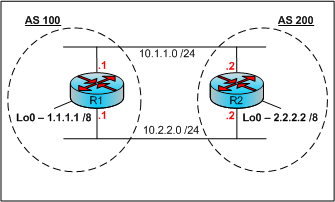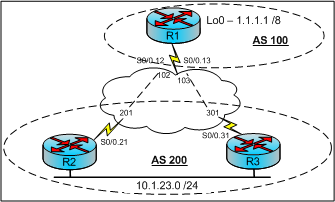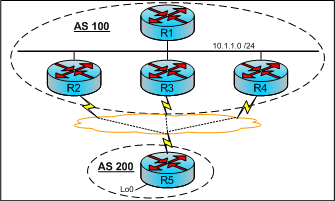 L’utilisation de l’interface Loopback, permet d’établir relation de voisinage entre 2 AS indépendamment du chemin utilisé
L’utilisation de l’interface Loopback, permet d’établir relation de voisinage entre 2 AS indépendamment du chemin utilisé
La session BGP établie entre R1 (1.1.1.1) et R2 (2.2.2.2) est load-balancée par le protocole de routage IGP sous-jacent (rip par exemple).
La session BGP n’étant plus directe, il est nécessaire d’augmenter le TTL (à 1 par défaut) des paquets tcp BGP en utilisant l’option « egbp-multihop »
R1 router rip version 2 network 1.0.0.0 network 10.0.0.0 no auto-summary ! router bgp 100 no synchronization bgp log-neighbor-changes network 1.0.0.0 neighbor 2.2.2.2 remote-as 200 neighbor 2.2.2.2 ebgp-multihop 2 neighbor 2.2.2.2 update-source Loopback0 no auto-summary
R2 router rip version 2 network 2.0.0.0 network 10.0.0.0 no auto-summary ! router bgp 200 no synchronization bgp log-neighbor-changes network 2.0.0.0 neighbor 1.1.1.1 remote-as 100 neighbor 1.1.1.1 ebgp-multihop 2 neighbor 1.1.1.1 update-source Loopback0 no auto-summary
Vérifications :
R2#show ip route r
R 1.0.0.0/8 [120/1] via 10.2.2.1, 00:00:17, FastEthernet0/1
[120/1] via 10.1.1.1, 00:00:10, FastEthernet0/0
BGP & Load balancing 2
Dans cet exemple, R1 a deux liens point à point avec l’AS200 lui permettant d’atteindre le réseau 10.1.23.0
R1#show run | begin router bgp router bgp 100 no synchronization bgp log-neighbor-changes neighbor 10.1.12.2 remote-as 200 neighbor 10.1.13.3 remote-as 200 no auto-summary
Par défaut, BGP n’installera qu’une route dans la table de routage, arbitrant sur l’ID du routeur BGP
R1#show ip bgp Network Next Hop Metric LocPrf Weight Path * 10.1.23.0/24 10.1.13.3 0 0 200 i *> 10.1.12.2 0 0 200 i
R1#show ip route bgp 10.0.0.0/24 is subnetted, 3 subnets B 10.1.23.0 [20/0] via 10.1.12.2, 00:02:45
maximum-paths permet de modifier ce comportement par défaut :
R1#conf t
R1(config)#router bgp 100
R1(config-router)#maximum-paths 2
R1#show ip route bgp
10.0.0.0/24 is subnetted, 3 subnets
B 10.1.23.0 [20/0] via 10.1.13.3, 00:00:44
[20/0] via 10.1.12.2, 00:00:44
Unequal-Cost Load balancing
Dans ce nouvel exemple, R1 (AS100) à trois chemin possible pour atteindre R5
Comme précédemment, R1 a une préférence de routage iBGP vers le router possédant l’ID le plus petit
R1#show ip bgp 5.0.0.0 BGP routing table entry for 5.0.0.0/8, version 4 Paths: (3 available, best #3, table Default-IP-Routing-Table) Multipath: iBGP Not advertised to any peer 200 10.1.1.4 from 10.1.1.4 (4.4.4.4) Origin IGP, metric 0, localpref 100, valid, internal, multipath 200 10.1.1.3 from 10.1.1.3 (3.3.3.3) Origin IGP, metric 0, localpref 100, valid, internal, multipath 200 10.1.1.2 from 10.1.1.2 (2.2.2.2) Origin IGP, metric 0, localpref 100, valid, internal, multipath, best
« maximum-paths ibgp » est ajouté à la configuration d’origine de R1 :
router bgp 100
no synchronization
bgp router-id 1.1.1.1
bgp log-neighbor-changes
network 10.1.1.0 mask 255.255.255.0
neighbor 10.1.1.2 remote-as 100
neighbor 10.1.1.3 remote-as 100
neighbor 10.1.1.4 remote-as 100
maximum-paths ibgp 3
no auto-summary
Vérifications :
R1#show ip route bgp B 5.0.0.0/8 [200/0] via 10.1.1.4, 00:10:51 [200/0] via 10.1.1.3, 00:10:51 [200/0] via 10.1.1.2, 00:13:19
dmzlink-bw
Les 3 liens Wan entre l’AS 100 et l’AS 200 ne sont pas du même type et n’ont pas la même bande passante.
Les informations de bande passante peuvent être prises en compte lors de la décision de routage en configurant « dmzlink-bw » sur chaque routeur de bordure.
« dmzlink-bw » est attribut de type community extended
Configuration des routeurs:
R1#conf t R1(config)#router bgp 100 R1(config-router)#bgp dmzlink-bw R2#conf t R2(config)#router bgp 100 R2(config-router)#neighbor 10.1.1.1 send-community extended R2(config-router)#bgp dmzlink-bw R2(config-router)#neighbor 10.1.25.5 dmzlink-bw R3#conf t R3(config)#router bgp 100 R2(config-router)#neighbor 10.1.1.1 send-community extended R2(config-router)#bgp dmzlink-bw R3(config-router)#neighbor 10.1.35.5 dmzlink-bw R4#conf t R4(config)#router bgp 100 R2(config-router)#neighbor 10.1.1.1 send-community extended R2(config-router)#bgp dmzlink-bw R4(config-router)#neighbor 10.1.45.5 dmzlink-bw
- 10.1.1.1 = R1
- 10.1.25.5, 10.1.35.5, 10.1.45.5 = R5
Vérifications depuis R1 :
R1#show ip bgp 5.0.0.0 BGP routing table entry for 5.0.0.0/8, version 8 Paths: (3 available, best #2, table Default-IP-Routing-Table) Multipath: iBGP Not advertised to any peer 200 10.1.1.4 from 10.1.1.4 (4.4.4.4) Origin IGP, metric 0, localpref 100, valid, internal, multipath DMZ-Link Bw 193 kbytes 200 10.1.1.2 from 10.1.1.2 (2.2.2.2) Origin IGP, metric 0, localpref 100, valid, internal, multipath, best DMZ-Link Bw 193 kbytes 200 10.1.1.3 from 10.1.1.3 (3.3.3.3) Origin IGP, metric 0, localpref 100, valid, internal, multipath DMZ-Link Bw 16 kbytes


